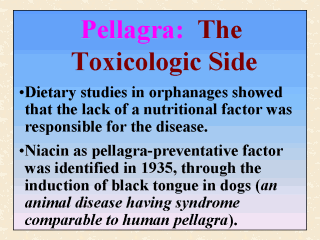 |
Following his
classic experiment on the Mississippi inmates (last slide), Goldberger conducted
controlled dietary studies in orphanages to advance his speculation that pellagra was a
nutritional rather than an infectious disease. These studies showed no development of
pellagra in those orphans who consumed a mixed, well-balanced diet. The results of these
classic and dietary studies led Goldberger to believe that certain pellagra-preventive
factors were missing in the poor Southern corn diet. In 1926, a member of the B-complex
vitamins was reported to be responsible for the cause of pellagra, at the time when
Goldberger thought the disease was due to a deficiency of tryptophan or cystine
(Sandstead, 1973). He died in January 1929, three months after giving his last public
address on pellagra at The American Dietetic Association. About six years later in 1935,
biochemist Conrad Elvehjem at the University of Wisconsin identified niacin as the
curative factor for black tongue in dogs. Black tongue in dogs is a disease having
syndrome and condition comparable to human pellagra. In that previous year, Elvehjem and
his colleague Carl J. Koehn had found that a filtrate factor from a liver extract could
cure diet-induced pellagra in chicks. That filtrate extract was designated as the vitamin
G fraction, after the late Goldberger. To confirm their findings in dogs, they induced
black tongue in these animals with the Goldberger diet of yellow corn, before
supplementing the diet with the vitamin G fraction. Elvehjem and his colleagues later were
able to isolate and identify nicotinamide and nictonic acid from vitamin G as the curative
factors for black tongue in dogs. |
